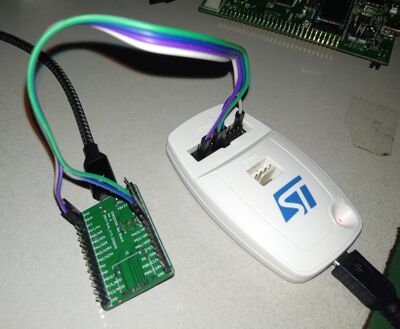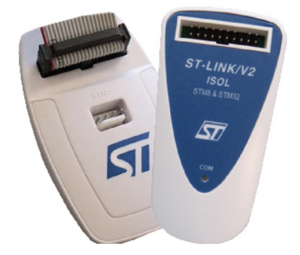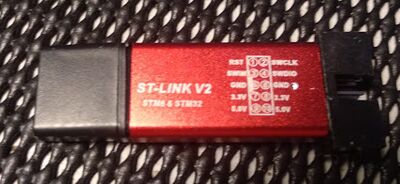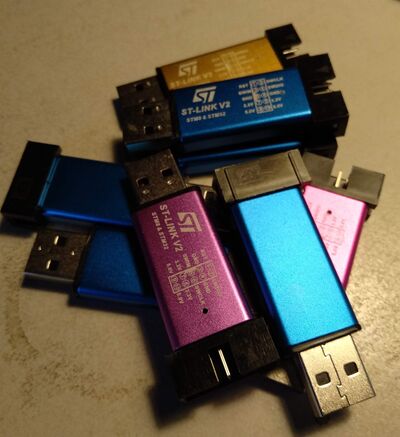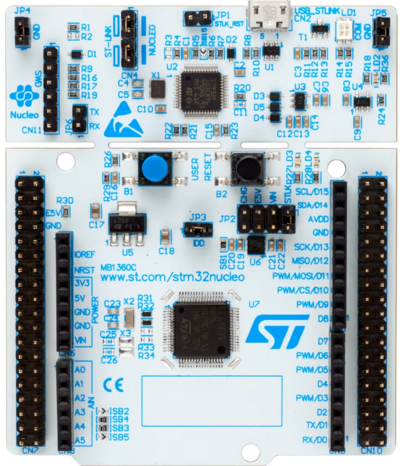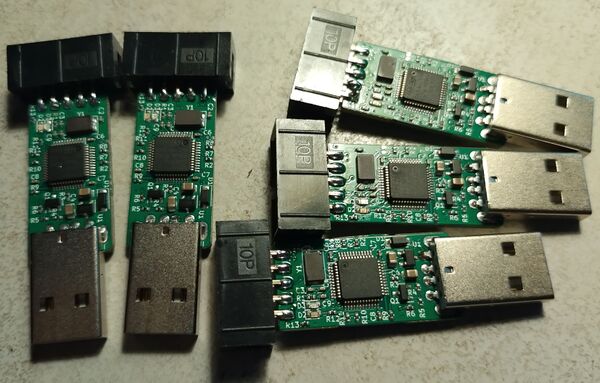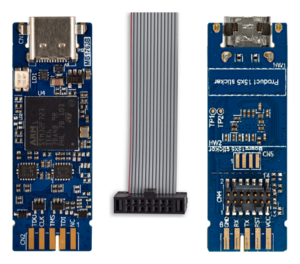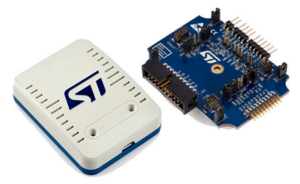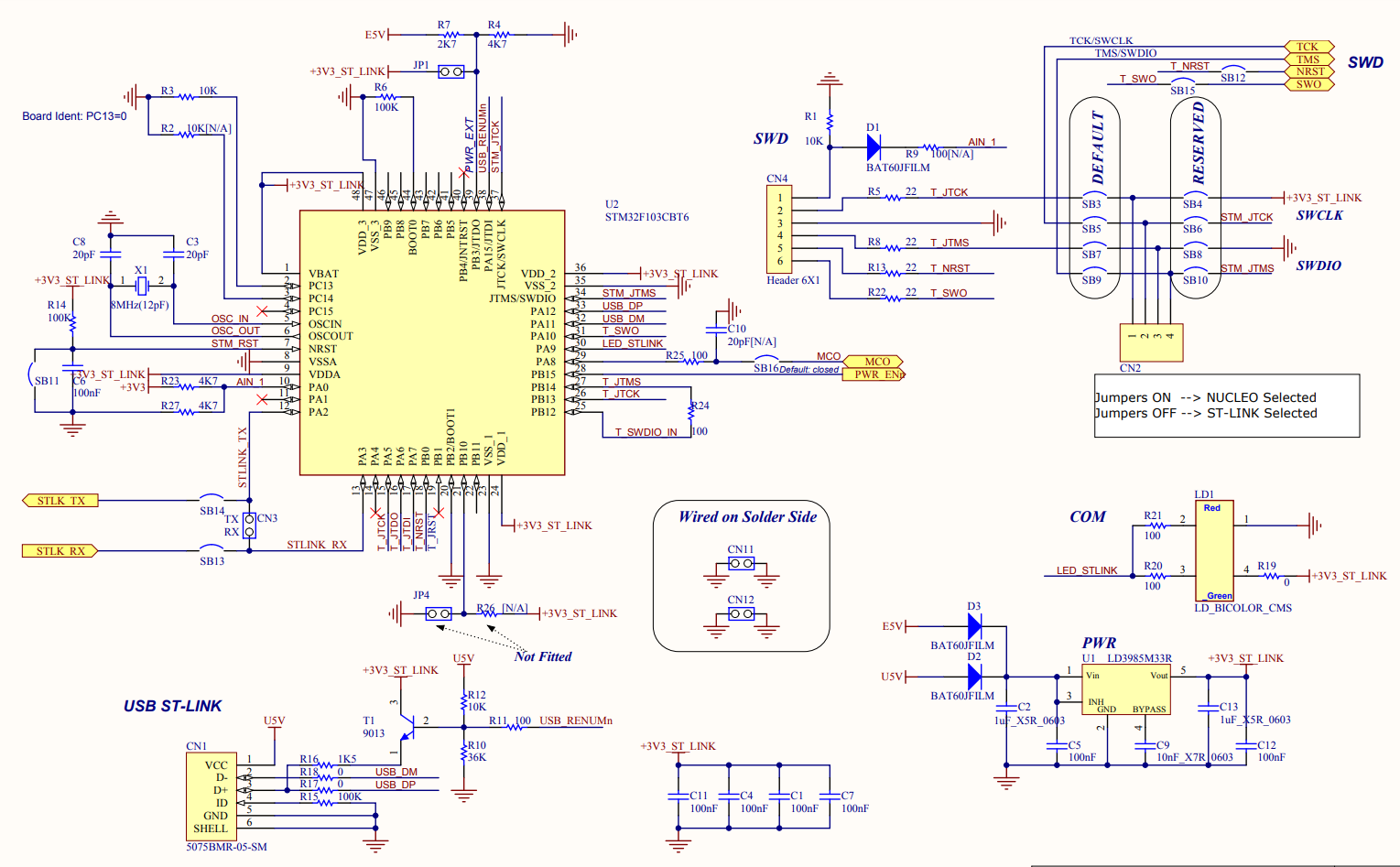ST-Link
There's a number of different ways to flash STM32 devices. One of these is to use ST's own ST-Link devices using the Serial Wire Debug (aka SWD) protocol.
There are multiple benefits of using one of these ST-Link devices rather than a plain serial dongle:
- The device need not be restarted in flash mode (Boot0)
- Programs can be debugged on the device
The official ST-Link as seen above are relatively cheap (< $20) and there are Chinese copies available (haven't tried those).
We are also running on a DIY ST-Link V2.1 device.
Video
We created a detailed video on the topic of using ST-Link.
ST-Link/V2
While there must have been a V1 at some point, the ST-Link/V2 displayed in the photo to the left was for years the one to use. The original can still be purchased from places like Mouser, but there are also plenty of exact Chinese clones around (exact as in they look exactly the same).
These ST-Link devices are enclosed in a quite large white plastic casing but for some truly bizarre reason, ST could not be arsed to put a legend on the device, so one either have to have a very good memory or Google the pin out constantly.
Another very common clone are these:
They are Chinese knock offs but they run the official ST-Link firmware and contrary to the official one they actually have the pin out legend printed on the box. Generally these devices work just fine but with certain limitations.
The V2 devices does not have any UART/Serial functionality. The original does have SWO (Serial Wire Output) which can be used to print debug information. The small Chinese knock-offs can be modified to include a SWO pin (see link here).
ST-Link/V2-1 (Nucleo)
For beginners, the Nucleo boards are absolutely brilliant. First of all, being official ST boards they obviously include an original STM32 MCU, but they do in fact include two MCUs and the second one acts like a ST-Link/V2-1 device. Contrary to the ST-Link/V2, this one does include a SWO pin AND a USB/UART interface.
ST-Link/V2-1 devices does not exist as a stand-alone product, but they can be broken off the Nucleo and used as a stand-alone device. The complete schematics is available in the manual of the Nucleo boards, so it is in fact possible to use this to build your own. An example of that is shown here: DIY STM32 Programmer (ST-Link/V2-1).
ST-Link/V3MINIE
To be added
ST-Link/V3SET
To be added
Hardware Analysis
ST does not make schematics or source code available for the official ST-Link devices, which is a pity (and a somewhat odd business decision). However, they do publish a partial schematics since a built-in ST-Link device is included in all their development boards, a partial schematics is available.
From the schematics we can see that the ST-Link device is build around a STM32F103CBT6 which is the 128 kB Flash version.
PC13 and PC14 (and possibly PC15 in the future) appears to be working as a means for the firmware to identify the "version" of the hardware. On above schematics, PC13 is pulled low with a resistor while PC14 (and PC15) are left floating.
A voltage divider splitting +3.3 V in half is connected to PA0 and labelled AIN_1. The ST-Link devices are capable of measuring the target processor supply voltage and this is probably a workaround of the development boards (which know their supply voltage already).
The "output" pins of the ST-Link V2 are as follows:
| Pin | Label | Remarks |
|---|---|---|
| PA0 | AIN_1 | Probably meant as an analog input, measuring the supply voltage on the target device. On the development boards, the supply voltage is well known, so this pin is connected to a voltage divider splitting the supply voltage in half (1.65V or thereabouts). |
| PA5 | T_JTCK | Target Clock |
| PA6 | T_JTDO | |
| PA7 | T_JTDI | |
| PA10 | T_SWO | Target trace debugging. This pin is unconnected on the Chinese clone ST-Links, which is annoying. |
| PA12 | T_SWDIO_IN | On development boards connected via a 100 Ohm resistor to PA14 |
| PA13 | T_JTCK | |
| PA14 | T_JTMS | |
| PB0 | T_NRST | |
| PB1 | T_JRST | Labelled but not connected to anything |
Upgrade issues
To be added
More Reading
Github user lujji have done a number of interesting writeups on ST-Link devices, reverse engineering the ST-Link firmware and adding trace (SWO) support to the cheap Chinese ST-Link devices.
